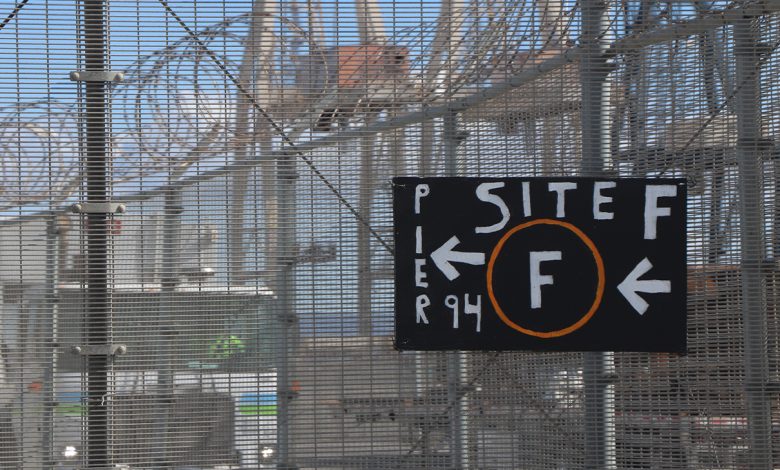City to Give Up More Than 100 Shelter Beds Without a Fight


By Joe Dworetzky
Bay City News
In a city struggling under the weight of a federal injunction that prevents removal of tent encampments because of a shortage of shelter beds, one might think that the threat of losing more than 100 existing beds would raise an outcry.
Apparently, not so.
On Tuesday, the Commissioners of the Port of San Francisco will hear a staff presentation about a proposal that would give the city 10 months to wind down operations of a site near Pier 94 where currently 118 people experiencing homelessness live in trailers.
If that proposal is approved, new intake will end on Sept. 30 and people living in the camp will be required to leave by Nov. 31.
Emily Cohen, Deputy Director for Communications & Legislative Affairs for the city’s Department of Homelessness and Supportive Housing (HSH), is hopeful that the proposal will be approved.
The location – called “Site F” – was spun up in April of 2020, just after the coronavirus pandemic hit. The port agreed to accommodate the trailers – 94 provided by the state 29 leased by the city – while the health emergency lasted.
The emergency ended on Feb. 28, and, according to Cohen, the agreement between the city and the port ended the arrangement at that time. “No one’s pulling a fast one on us here,” Cohen said. “This is something that was always a part of the agreement, always a part of the understanding.”
Cohen said that port lands are dedicated for maritime uses and Site F was only allowed because of the COVID-19 emergency. According to Cohen, “The port’s hands are tied here. I don’t think they have the authority to allow this.”
Cohen says that the department would be thrilled to stay longer but will be thankful to get 10 months to close things up in a gradual and responsible way. The department hopes that it will be able to get a significant number of individuals into permanent housing and promises to work with the remainder to find shelter beds.
Most of the people living at Site F are from Bayview. Gwendolyn Westbrook, the controversial CEO of United Council of Human Services, has been involved with Site F since its inception. (UCHS has a contract with the city to operate the site, although according to an April 7 port staff report, “During the winddown, HSH will be changing site operators so there will be no subcontractor role with United Council after June 30, 2023.”)
In an interview Wednesday with Bay City News, Westbrook expressed concern over what would happen to the people at Site F if it were to close.
Westbrook says that despite the city’s hopes, many Site F residents will be back on the streets if Site F closes. She says Bayview is their home and many would rather be on the streets in Bayview than in a city shelter or navigation center elsewhere.
“They don’t want to go to the navigation center,” she said. “Navigation center has been there before these [trailers] were here, but they were living on the street. They could have went to the navigation center there…. They’re not going to no nav center. They are not.”
Westbrook wishes that city would fight to keep assets like Site F that benefit the Bayview community she serves. She asks, “Why would you close shelter places?”
Cohen isn’t as concerned. She said that the department has heard similar concerns before the closing of shelter-in-place sites but, when closure was imminent, residents were often willing to accept housing. But she acknowledges that “people do have strong ties to their neighborhoods.”
The seemingly genial closure of Site F comes despite a series of events that have made the availablity of shelter beds a matter of urgency.
A federal judge in December of 2022 enjoined the city from continuing to close tent encampments on city streets while there is a shortage of shelter beds.
According to testimony in the federal case, the city is short 4,397 shelter beds. The shortfall is so acute that the city has closed the shelter system to anyone unless referred by city workers.
This has created a situation in which the handful of beds that free up on a given day (as individuals exit the shelter system for housing or hospitalization or to return to the streets, etc.) are doled out bed-by-bed when city workers visit encampments.
Between the profound bed shortage and the injunction, conditions on the street have triggered an outcry from neighbors and businesses, and the languid pace at which HSH – the city’s lead agency on homelessness – is addressing the shortage of shelter beds has become an issue itself.
The City Board of Supervisors held a hearing on March 21 to consider what was supposed to have been a plan from HSH to end unsheltered homelessness.
The department declined to submit a plan because even with an additional $1.45 billion (a sum HSH reduced to $992 million hours before the hearing) and three years to spend it, the goal could not be achieved. (Public records reviewed by Bay City News showed that in earlier versions of the department’s report, it had proposed a nine-year effort to the same end but dropped the alternative from the final draft.)
District 8 Supervisor Rafael Mandelman so outraged by the department’s response that he said it was time to consider if HSH was the right agency to lead the city’s effort to deal with the problem of unsheltered homelessness.
At a press conference called by Mandelman before the hearing, resident groups and business owners talked in harsh terms about the impact that homelessness and crime are having on the city.
Perhaps the harshest words came from Barbara Perzigian, general manager of Hotel VIA, which is located near Oracle Park in the city’s South Beach neighborhood.
She said that San Francisco has “become the city where no one wants to go.”
In her opinion, unsheltered homelessness must be addressed with urgency. “We don’t have three years to wait because we’re all going to be out of business. We need to clean up the streets,” she said.
Beyond the loss of beds, the closure of Site F is another blow to the efforts of the city to test potential alternatives to traditional shelter models.
While Site F has not been without its share of problems, it has provided residents with personal space and autonomy that are missing in other models. Cohen says that more 300 people have been served at the site over the three years of operation and 38 have moved on to permanent housing.
She said, “it’s something we would certainly consider replicating if we could find the property for it… [but] finding a site appropriate for this stuff is incredibly hard.”
Each trailer at Site F contains a kitchen and bathroom and is powered by 24/7 electric service. There is a small medical clinic at the site.
Although the location is remote, there is a limited shuttle bus service. Many of the residents have cars and, according to program manager DeShawn Waters, many use them to get to work.
The impact of losing a site with three years of up-and-running operation is sharply evident when compared to the city’s difficulties in creating “Vehicle Triage Centers.”
After a pilot VTC with space for 29 vehicles closed in 2021, the city set out to create two more but only one has been implemented because despite months and months of searching, the city has not been able to find a suitable site for the second.
The one that has been put in place – the Bayview VTC – has been a parade of mistakes.
Despite a plan to create safe parking for 150 RVs, each connected to electric service, the city is 15 months into a 24-year lease without power and a site that only accommodates 49 vehicles.
A Bay City News analysis in February showed that the city spent a staggering annual $170,000 per person at the site in the first year of operations.
Given that experience, a site that has been in operation for three years would seem particularly valuable.
While the decision to extend the current arrangements beyond ten months is made by the port commissioners, the city is not without influence: the mayor appoints the port’s five commissioners and the supervisors approve their appointments.
The contention that Site F can only be sited on port land during a period of emergency appears open to question.
The Embarcadero Navigation Center is also on port lands and the supervisors recently approved a further extension of its operation to 2027. While that extension is subject to port commission approval, it seems unlikely that the supervisors would have bothered with the extension if the port was truly powerless to allow the use.
While the Burton Act and the public trust doctrine limit the use of port lands, the commission has found flexibility in the past to approve a wide variety of uses over the 800 acres it manages.
The greatest flexibility seems to be reserved for “interim uses” that pay market rate rent, only use temporary structures and do not prevent ultimate long-term development of the site. Interim uses need not be used for trust purposes.
The city’s Waterfront Plan says the area where Site F is located (Seawall Lot 344) can be made available for “interim uses” for up to 10 years.
But even if an emergency were required to use the port space, it would not seem unreasonable to conclude that the combination of the city’s lack of shelter beds and the federal injunction have created an emergency situation. (When the court order was entered, City Attorney David Chiu said publicly that the city was in “an impossible situation.”)
The question of whether HSH is pulling out all the stops to preserve the beds at Site F is likely to be of interest to at least some of the supervisors.
At a March 15 hearing of the supervisor’s Budget and Finance committee, Mandelman and District 11 Supervisor Ahsha Safai were very focused on whether HSH was doing all it could to get additional shelter beds in operation.
The supervisors called out the fact that the Embarcadero Navigation Center was only operating with 120 beds even though it was authorized for 200.
When Safai pressed for an explanation of why the city has left 80 possible shelter beds empty, HSH spokesperson Dylan Schneider said the city did not have the beds.
Having just heard about the authorization for 200 beds, Safai expressed confusion.
Schneider said the problem was the city had run out of beds — actual beds, the sort with four legs.
She blamed the supply chain.
Clearly troubled by her answer, Safai said, “with the crisis on the street, to have beds sitting empty for as long as they have been, we have to come up with a better solution, we have figure something out.”
He continued, “I understand that the supply chain is real, but that doesn’t feel like an acceptable answer.”
It remains to be seen if HSH’s 10-month winddown at Site F is any more acceptable.
Copyright © 2023 Bay City News, Inc. All rights reserved. Republication, rebroadcast or redistribution without the express written consent of Bay City News, Inc. is prohibited. Bay City News is a 24/7 news service covering the greater Bay Area.




